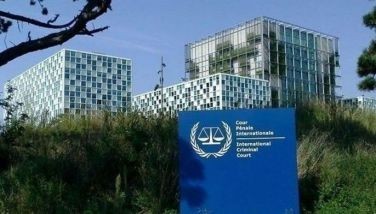Remaining Mayon evacuees sent home
LEGAZPI CITY , Philippines – Disaster management officials here allowed yesterday the 510 families who evacuated from the slopes of the restive Mayon volcano to return home, after drills showed that residents near the six-kilometer permanent danger zone could be evacuated again in just 15 minutes.
Albay Gov. Joey Salceda confirmed that he approved the return of the evacuees to their homes after officials identified and tested the shorter and safer escape routes to quickly evacuate within 15 minutes residents in Bañadero in Daraga town, and in the upper portion of Barangay Padang in Legazpi City.
“With this, we will start bringing them back to their dwelling villages today,” Salceda told The STAR yesterday, adding that more cash and food would be delivered to the houses of the evacuees.
The Philippine Institute of Volcanology and Seismology (Phivolcs) had lowered the alert level around Mayon volcano from level 4 to 3 last Saturday after volcanic activity decreased.
Alert level 3 means the volcano is still in a state of relatively high unrest and an eruption is still possible within weeks.
Salceda ordered the partial return of residents to their homes from evacuation centers, which are located mostly in public schools that were set to resume classes after the holidays.
He, however, warned farmers, media men and tourists from entering the six-kilometer permanent danger zone (PDZ).
“The lava front is well within the six-kilometer radius permanent danger zone and there is significant residual risk from toxic sulfur fumes and gases, rock falls, fragments and sudden ash explosions,” Salceda said.
“With these threats, the Provincial Disaster Coordinating Council (PDCC) is warning tourists, tourist guides, farmers and the media from getting inside the six-kilometer PDZ,” Salceda said, adding that the joint Task Force Mayon would enforce the ban through the checkpoints and foot patrols.
Salceda ordered Col. Romeo Salazar, commanding officer of the 901st Infantry Brigade and member of the joint Task Force Mayon, to use global positioning system (GPS) to clearly delineate the 6-kilometer permanent danger zone and put visible markers so it will be easy to determine the high-risk zone.
Fewer volcanic quakes
Phivolcs recorded fewer volcanic earthquakes in the last 24 hours but maintained alert level 3 over the restive volcano.
Phivolcs director Renato Solidum said the seismic monitoring network detected seven volcanic earthquakes and 33 rock fall events related to the detachment of lava fragments at the volcano’s upper slopes during the past 24 hours.
He said steaming activity was not observed due to thick clouds that covered the crater.
Solidum said sulfur dioxide was not measured on Sunday due to rain.
Phivolcs maintained alert level 3, which means that magma is close to the crater and eruption is possible within weeks.
Solidum said over the weekend that they might lower further the alert status of Mayon from 3 to 2 if the volcano’s activities continue to subside in the next days.
He said that there should be no human activity in the six-kilometer permanent danger zone around the volcano and the seven-kilometer extended danger zone on the southeast slope of the volcano because of sudden explosions that may generate hazardous volcanic flows.
“People residing close to these danger areas are also advised to observe precautions associated with post-eruption activity, such as rock fall, pyroclastic flows, and ash fallout which can also occur anytime due to instabilities of lava deposited on steep slopes,” Solidum said.
He said the active river channels and those identified as lahar prone areas in the southern slope should also be avoided especially during bad weather conditions or when there is heavy and prolonged rainfall.
Salceda said local officials have started distributing to the evacuees the additional 25 kilos of rice per family after the United Nations World Food Program delivered the 250 metric tons of rice to the Provincial Disaster Coordinating Council (PDCC) building.
He also announced the release of the P14 million as cash-for-work assistance of P1,400 per family even though the evacuees were already sent home.
Teams of doctors and nurses from the Armed Forces of the Philippines (AFP) and government agencies had also started to visit villages to give free medical checkups, he said.
“We want to make sure that no one will get sick after they left the evacuation centers,” Salceda stressed out.
Salceda said the successful evacuation was made through the cooperation of the evacuees, local government units, and non-government groups.
“Thank you for the prayers. This is the 12th time Albay executed preemptive evacuation and the disaster did not materialize. We did it against typhoons ‘Mina’, ‘Lando’, ‘Nonoy’, the tailend of the cold front, typhoon ‘Frank’, low-pressure area, tropical depressions ‘Dante’, ‘Ondoy’, ‘Pepeng’, ‘Ramil’, ‘Santi’. It seems that preemptive evacuation is a community prayer in humility to God’s will and respect for nature and similarly a collective plea to preempt the disaster from materializing,” Salceda said.
The provincial government also distributed 15 kilos of rice for the evacuees who are returning to their homes and P15 million for crop rehabilitation, including two tractors from the Department of Agriculture (DA).
Eruption will be milder
Ed Laguerta, Phivolcs resident volcanologist who has monitored Mayon volcano’s eruptions since 1968, said the possible eruption of the volcano would be less violent than the 1814 or 1984 incidents based on historical accounts and statistical probabilities.
Laguerta said Mayon’s average volume of ejected volcanic materials per eruption was placed at 50 to 60 million cubic meters.
The volcano’s most violent eruption was on Feb. 1, 1814 when Mayon ejected volcanic debris estimated at 150 million cubic meters that buried the Cagsawa church and adjacent villages when lahar and boulders were washed down by heavy rains months later.
The five major gullies and channels around Mayon are currently full after the latest lava flows and debris emitted, which were estimated at 35 to 45 million cubic meters.
“And with these volumes, there could still be hazardous eruption due to possible presence of pyroclastic flows or towering ash columns, but not as violent as the 1984 or even 2000 eruptions,” Laguerta said.
Laguerta said that the recent intervals of restive activity are similar to the volcanic unrest experienced in 1958, 1968, and 1978.
Mayon became restive again in 1984 and the volcano erupted in 1993 killing more than 70 farmers, Laguerta said.
He said the volcano again showed signs of activity in 2000 and 2001. Ash explosions and lava flows were recorded in 2006.
Ash fall and lava flows again started last Dec. 14 and Phivolcs officials are still monitoring the restiveness of the volcano after activity mellowed down before the start of the New Year.
He did not discount the possibility of Mayon still erupting in the coming days.
Meanwhile, Phivolcs instruments detected only seven volcanic earthquakes and 30 rock fall events in the past 24 hours, as it said that should the unrest continue to decline, alert level 3 could be furthered lowered. With Helen Flores, Celso Amo
- Latest
- Trending


























